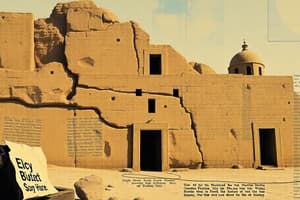Podcast
Questions and Answers
What period coincided with the last phase of the Pleistocene?
What period coincided with the last phase of the Pleistocene?
- Mesolithic
- Lower Palaeolithic
- Upper Palaeolithic (correct)
- Middle Palaeolithic
Which of the following sites is NOT associated with the Lower Palaeolithic?
Which of the following sites is NOT associated with the Lower Palaeolithic?
- Belan Valley
- Bhimbetka (correct)
- Didwana
- Soan/Sohan
What technology was primarily used during the Middle Palaeolithic period?
What technology was primarily used during the Middle Palaeolithic period?
- Flake technology (correct)
- Fire-making techniques
- Metalworking
- Polished stone tools
Which event marked the beginning of the Holocene?
Which event marked the beginning of the Holocene?
Which term describes the Upper Palaeolithic period?
Which term describes the Upper Palaeolithic period?
What was the main occupation during the Lower Palaeolithic period?
What was the main occupation during the Lower Palaeolithic period?
In which geographic location is the Didwana site found?
In which geographic location is the Didwana site found?
What type of tools were primarily associated with the Mesolithic period?
What type of tools were primarily associated with the Mesolithic period?
Which period is characterized by the use of stones to make tools?
Which period is characterized by the use of stones to make tools?
What major development distinguishes the Neolithic period from earlier periods?
What major development distinguishes the Neolithic period from earlier periods?
During which time frame did the Mesolithic period occur?
During which time frame did the Mesolithic period occur?
What does the term 'Proto-historic' refer to?
What does the term 'Proto-historic' refer to?
Which age is known for the transition from stone tools to metal tools?
Which age is known for the transition from stone tools to metal tools?
In which era did the use of written text become prominent?
In which era did the use of written text become prominent?
What does the abbreviation AD stand for?
What does the abbreviation AD stand for?
How is the Bronze Age characterized in historical terms?
How is the Bronze Age characterized in historical terms?
Which early site is known for the domestication of rice in 7000 BC?
Which early site is known for the domestication of rice in 7000 BC?
What type of burial practice was predominantly observed in early communities?
What type of burial practice was predominantly observed in early communities?
Which of the following regions is associated with the earliest evidence of millet cultivation?
Which of the following regions is associated with the earliest evidence of millet cultivation?
Which metal was the first to be discovered by humans during the Copper Age?
Which metal was the first to be discovered by humans during the Copper Age?
Which site is known as the earliest location for domestication of animals?
Which site is known as the earliest location for domestication of animals?
Where is the region known for the Chalcolithic Age located?
Where is the region known for the Chalcolithic Age located?
Which pottery style was commonly used by rural communities during the Copper Age?
Which pottery style was commonly used by rural communities during the Copper Age?
Which of the following does NOT belong to the list of major sites in South-eastern Rajasthan?
Which of the following does NOT belong to the list of major sites in South-eastern Rajasthan?
What type of climate changes occurred during the transitional phase between the Palaeolithic and Neolithic periods?
What type of climate changes occurred during the transitional phase between the Palaeolithic and Neolithic periods?
Which site provides the earliest evidence of animal domestication?
Which site provides the earliest evidence of animal domestication?
During the Neolithic period, what material was primarily used to store excess food grains?
During the Neolithic period, what material was primarily used to store excess food grains?
Which of the following sites is known as the 'cave of potters'?
Which of the following sites is known as the 'cave of potters'?
Which crop was NOT mentioned as cultivated in Mehrgarh?
Which crop was NOT mentioned as cultivated in Mehrgarh?
Which site's inhabitants lived beside a lakeside and had burial practices for their domestic dogs?
Which site's inhabitants lived beside a lakeside and had burial practices for their domestic dogs?
What characterized the lifestyle of Neolithic people?
What characterized the lifestyle of Neolithic people?
Which of the following sites is located in Southern Tamil Nadu?
Which of the following sites is located in Southern Tamil Nadu?
Flashcards
Stone Age
Stone Age
The earliest period of human history, characterized by the use of stone tools.
Paleolithic Age
Paleolithic Age
The first part of the Stone Age, from around 500,000 to 10,000 BC characterized by hunting and gathering of food, use of flake tools, and early humans.
Mesolithic Age
Mesolithic Age
A transitional period in the Stone Age, between the Paleolithic and Neolithic, marked by the transition to agriculture.
Neolithic Age
Neolithic Age
Signup and view all the flashcards
Chalcolithic Age
Chalcolithic Age
Signup and view all the flashcards
Palaeolithic phases
Palaeolithic phases
Signup and view all the flashcards
Archaeology
Archaeology
Signup and view all the flashcards
Megalith
Megalith
Signup and view all the flashcards
Early agriculture
Early agriculture
Signup and view all the flashcards
Ice Age
Ice Age
Signup and view all the flashcards
Study Notes
Stone Age Overview
- The Stone Age marks the earliest period of human history, characterized by the use of stone tools.
- Subdivided into three distinct periods: Palaeolithic, Mesolithic, and Neolithic based on the types of stone used.
Palaeolithic Age
- Spanned from approximately 5 Lakh BC to 10,000 BC.
- Three phases:
- Lower Palaeolithic (5 Lakh-50,000 BC): Known for hunting and gathering; flake technology emerged; significant sites include Soan, Belan Valley, and Bhimbetka.
- Middle Palaeolithic (50,000-40,000 BC): Characterized by advancements in tool-making; coincided with the Ice Age.
- Upper Palaeolithic (40,000-10,000 BC): Last phase of Pleistocene; associated with the emergence of Homo sapiens.
Mesolithic Age
- Occurred between 9000 BC and 4000 BC; marked the transition to the Neolithic period.
- Featured warmer climate with increased flora and fauna.
- Notable sites include:
- Langhnaj (Gujarat)
- Bhimbetka (Madhya Pradesh)
- Chopani Mando (Uttar Pradesh)
- Bagor (Rajasthan) - evidence of early animal domestication.
Neolithic Age
- Lasted from approximately 7000 BC to 1000 BC.
- Noteworthy for the establishment of agriculture and food production.
- Significant sites:
- Mehrgarh (Baluchistan) - early evidence of homes and farming (wheat, barley, cotton).
- Burzahom (Kashmir) - domestication of dogs.
- Gufkral - known as the cave of potters.
- Evidence of property ownership and rock art (Bhimbetka).
Chalcolithic Age (Copper Age)
- Introduction of copper tools, marking the transition to metal usage.
- Sites dedicated to copper tool production located in:
- Southeastern Rajasthan (Ahar, Gilund).
- Eastern India (Chirand).
- Western Madhya Pradesh (Malwa region).
- Burial practices included urn burials, and pottery developed in black and red ochre colors.
Key Geological Facts
- Earth is approximately 4 billion years old, with the Quaternary stage housing the Pleistocene and Holocene epochs.
- Major climatic events included the Ice Age, shaping early human habitation patterns.
Archaeological Terminology
- Archaeology involves studying past human behavior through excavated artifacts.
- No written records exist for prehistoric times; therefore, understanding relies heavily on archaeological findings.
Miscellaneous
- The term 'Megalith' refers to large stones used in graves or memorials.
- The word "India" is derived from "Sindhu," the Sanskrit name for the Indus River.
Notable Pottery
- Different periods showcased distinct pottery styles, emphasizing functionality for food storage.
- Black and red pottery became hallmark characteristics of the Neolithic and Chalcolithic periods.
Studying That Suits You
Use AI to generate personalized quizzes and flashcards to suit your learning preferences.




